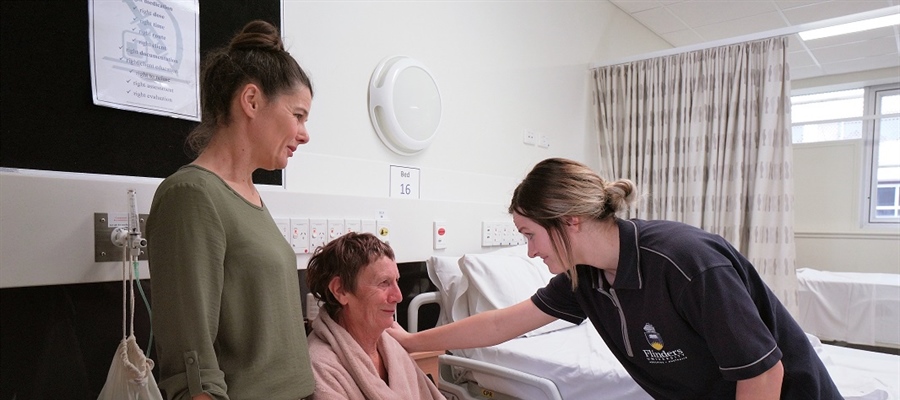Four new eLearning modules assist health care professionals about end-of-life care in acute hospitals
641 0
A blog post written by Kim Devery, Project Lead of End-of-Life Essentials, Senior Lecturer, College of Nursing and Health Sciences, Flinders University

The experiences of individual patients at the end of life are varied, but commonly include an increase in the intensity of symptoms and an uncertainty of what lies ahead. People who are facing the end of life and who are frightened or unwell seek assistance from our health care systems and many people seek assistance from our acute hospital system.
Did you know that in the last 12 months of life people can have an average of four admissions to acute hospitals?[1] Up to 75% of people at the end of life can present at least once to the emergency department in the last two of years of life.[2]
From these statistics we learn that patients at the end-of-life may have made multiple trips to acute hospitals and their illness highly likely to affect their quality of life. Ultimately, every health care professional needs to know about end-of-life care.
End-of-Life Essentials have produced new online education that’s free and evidence-based to assist professionals in increasing their capacity and confidence in end-of-life care.
The new education now available includes:
- End-of-life care in Emergency Departments
- Paediatric end-of-life care
- End-of-life care in chronic complex illness
- Imminent death – how to respond
End-of-life care can happen in any part of the hospital system. Being prepared is the key for doctors, nurses and allied health professionals. End-of-Life Essentials uses as foundation the Consensus Guidelines from the Australian Commission on Safety and Quality in Health Care.
Every module includes self-reflection learning opportunities which means that no matter how skilled or how inexperienced, every clinician can grow and learn more.
Interwoven in all the End-of-Life Essentials education is a focus on clinical compassion with a recognition that compassion in fast paced environments can happen. Along with gathering data on the patient’s biomedical situation learners are encouraged to consider the patient’s point-of-view as essential in understanding their presentation to an acute hospital. Consider the following acts of compassion and think about what you would be comfortable adopting:
- Show your full attention
- Ask – who should be here to be with and support you?
- Sit at the patient’s eye level Listen to the patient’s story of ill-health
- Understand that some conversations are overwhelming so be prepared to offer repeated clarification
- Use words that the patient can understand
- Always ask - Do you have any questions for me?
To show empathy in end-of-life care is so important. Understanding what is important from a patient’s point of view is one way clinicians can shift their mindset towards end-of-life care.
What is a good death?[3]
To know when death is coming, and to understand what can be expected
To be able to retain control of what happens
To be afforded dignity and privacy
To have control over pain relief and other symptom control
To have choice and control over where death occurs (at home or elsewhere)
To have access to information and expertise of whatever kind is necessary
To have access to any spiritual or emotional support required
To have access to hospice care in any location including home, not only in hospital
To have control over who is present and who shares the end
To be able to issue advance directives that ensure wishes are respected
To have time to say goodbye, and control over other aspects of timing
To be able to leave when it is time to go, and not to have life prolonged pointlessly
Being prepared for and instigating conversations with patients and families is covered in all of the new online education.
References
- Agency for Clinical Innovation (ACI). Fact of Death Analysis 2011/12 – Use of NSW public hospital services in the last year of life by NSW residents. Chatswood (NSW) ACI;2015 Sep.
- New South Wales Department of Health. Guidelines for end-of life care and decision-making (163KB pdf). Gladesville (NSW): NSW Department of Health; 2005 Mar. Updated 2021 Apr. 3Smith, R. (2000) 'A good death', British Medical Journal, 320 (15 January).

Kim Devery, Project Lead End-of-Life Essentials
Senior Lecturer, College of Nursing and Health Sciences, Flinders University